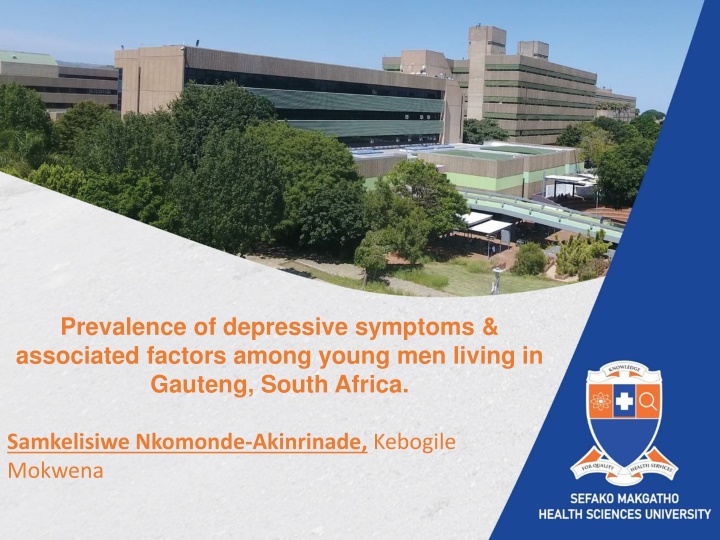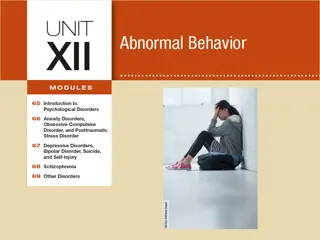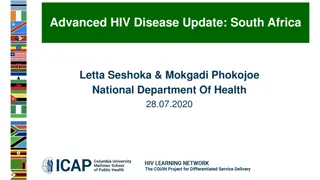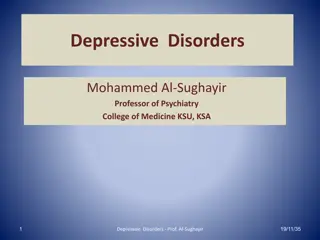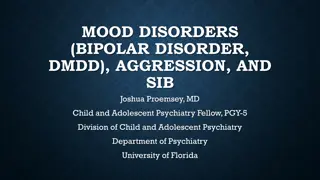Prevalence of Depressive Symptoms Among Young Men in Gauteng, South Africa
This study examines the prevalence of depressive symptoms and associated factors among young men in Gauteng, South Africa. The research focuses on understanding mental health challenges in this population and aims to shed light on the under-reported issue of depressive symptoms. The methodology, objectives, and results of the study are outlined, providing valuable insights into the mental well-being of young men in South Africa.
Download Presentation

Please find below an Image/Link to download the presentation.
The content on the website is provided AS IS for your information and personal use only. It may not be sold, licensed, or shared on other websites without obtaining consent from the author.If you encounter any issues during the download, it is possible that the publisher has removed the file from their server.
You are allowed to download the files provided on this website for personal or commercial use, subject to the condition that they are used lawfully. All files are the property of their respective owners.
The content on the website is provided AS IS for your information and personal use only. It may not be sold, licensed, or shared on other websites without obtaining consent from the author.
E N D
Presentation Transcript
Prevalence of depressive symptoms & associated factors among young men living in Gauteng, South Africa. Samkelisiwe Nkomonde-Akinrinade, Kebogile Mokwena
BACKGROUND TO THE STUDY Mental health disorders are a major contributor to the burden of disease globally. In South Africa, neuro-psychiatric disorders are the third largest contributor to the burden of disease after HIV/AIDS. Mental disorders are still under-reported in lower income countries like South Africa, largely due to the lack of studies conducted on mental health. Currently, there is a shortage of studies conducted on depressive symptoms among the general population, including young men living in South Africa.
STUDY OBJECTIVES The objectives of this study were: To determine the prevalence of depressive symptoms among young men living in Gauteng, South Africa. To explore the factors associated with depressive symptoms among young men living in Gauteng, South Africa.
METHODOLOGY Ethics approval: Obtained from Sefako Makgatho University Research Ethics Committee (SMUREC) Permission to conduct the study was obtained from: Gauteng Provincial Department of Health, Johannesburg Health District research committee Management of each clinic
METHODOLOGY (Cont.) Design: Across-sectional quantitative survey Sample size: n= 405 Sampling: Target group: Young men between the ages of 18-35 years residing in Soweto. The participants were found at 3 public health facilities in Soweto, namely, Moroka clinic, Michael Maponya clinic and Zola clinic. Simple random sampling was used and the participants were chosen upon presentation to the outpatient department at the clinics.
METHODOLOGY (Cont.) Data collection tools: The Patient Health Questionnaire (PHQ-9) was used to screen for depressive symptoms . This tool is internationally validated and found to be accurate, even in the South African context. The PHQ-9 was administered by the researcher. Another questionnaire was used to capture socio- demographic data of the participants & was also administered by the researcher. Data analysis:STATA version 14 was used to analyze the data.
RESULTS The study found that 39.3% of the participants had depressive symptoms with varying degrees of severity. The ages of the participants ranged from 18 to 35, with a mean of 27.67 . A majority (85.19%) (n=345) of the participants were single, while 14.57% (n= 59) were married. The unemployment rate was very high among the young men at 63.95% (n= 259). The majority (81.48%) (n= 330) of the participants attended school up to high school, while 18.27% (n= 74) progressed to tertiary level. Alcohol consumption amongst men was high at 80.25% (n= 325).
RESULTS Bar chart illustrating the prevalence of depressive symptoms among young men . 70.0% no depression, 60.7% 60.0% 50.0% 40.0% Mild, 26.2% 30.0% 20.0% Moderate, 8.4% 10.0% moderate severe, 2.5% Severe, 2.2% 0.0% Mild Moderate Severe moderate severe no depression
RESULTS: MARITAL STATUS Pie chart illustrating the marital status of the participants Widowed 0% Married 15% Single Married Widowed Single 85%
RESULTS: EMPLOYMENT STATUS Pie chart illustrating employment status among the men. Employed, 36% Employed Unemployed Unemployed, 64%
RESULTS: ALCOHOL USE Pie chart illustrating alcohol use among the participants No 20% Yes No Yes 80%
RESULTS: FACTORS ASSOCIATED WITH DEPRESSIVE SYMPTOMS The Pearson chi-square test was used to determine the association between depression and age, marital status, employment status, alcohol use, level of education, presence of chronic illnesses and access to health facilities. Using Pearson chi-square test of association *(p-value =0.05), factors significantly associated with depressive symptoms were: Marital status (0.06) Employment status (0.0) Use of alcohol (0.05)
Statistical significance using logistic regression for variables associated with depressive symptoms On logistic regression: Use of alcohol (0.11)** Employment status (0.000) * Marital status (0.59) ** *Significant at p-value of 0.05 **Significant at p-value 0.1
DISCUSSION There is a high prevalence of depressive symptoms among young men living in Gauteng, South Africa. Unemployment was identified as the leading factor associated with depressive symptoms. Unemployed men are vulnerable to depression. Alcohol use & marital status were found to be strongly associated with depressive symptoms. Unmarried men were found to have higher levels of depressive symptoms. Using logistic regression, only employment status was found to have statistical significance.
CONCLUSION The association between depressive symptoms & unemployment highlights the impact that socio- economic status has on mental health. The high prevalence of depressive symptoms among young men also highlights the dire need for routine screening for depression in the primary health care setting. Unless routine screening is integrated into the primary health care setting, people with depression will continue to be missed for diagnosis and treatment, with dire social and health outcomes.
LIMITATIONS OF THE STUDY The COVID-19 pandemic has compromised the mental health of a lot of people and this may resulted in higher rates of depression and the study could not differentiate between pre-COVID spread and levels of depression.
RECOMMENDATIONS Based on the results of the study, the following interventions are recommended: All community health centres need to have a functional mental health department, one that is accessible to all, fully staffed with individuals who are competent and professional. Primary health care workers need to receive on-going training on mental health disorders, particularly male depression. All men who present to primary health care facilities should be screened for depressive symptoms using an easy tool such as the PHQ-9 questionnaire.
ACKNOWLEDGEMENTS Department of Public Health at Sefako Makgatho Health sciences university. My supervisor & co-contributor Prof. Kebogile Mokwena. The young men who agreed to be participants of this study. The staff at Zola clinic, Michael Maponya clinic and Moroka clinic in Soweto.
